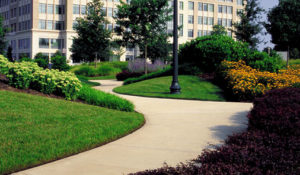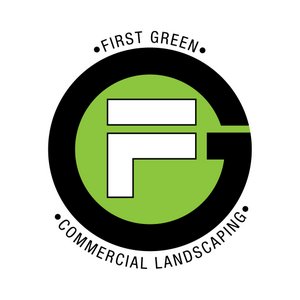 Turf grass not only is one of the most widespread used grasses in the U.S., but it also provides many natural benefits to our environment. Turf grass covers 46.5 Million acres in the United States and can be found in many places ranging from recreational parks to country fields. Some of the benefits Turf grass provides include converting carbon dioxide into oxygen, absorbing pollutants from run-off, and protecting soil from wind and water absorption among several others. We love to see this beautiful lush green lawn but why is our turf full of weeds? Can we fix it? Are we looking for a quick fix or a ling term solution? At First Green we are trying to move away form tradition chemical turf programs that rely on substances that are not healthy for the soil, the air, the wildlife, our water supply, or for humans. Chemicals are a quick fix, weeds will always return. Quick-release fertilizer and over-fertilization leads to lush top growth and weak roots, making turf less drought resistant. Once Chemicals are used your turf will be dependent on them to remain green and weed free. the other thing that is a downside to the chemicals is that they actually harm the soil. Healthy soil is what creates healthy plants; so to achieve visible results in turf grass vitality, soil health must be addressed.T So if you are frustrated by weeds in your turf grass, read on. Those weeds are a symptom of deeper issues that can be addressed with a more sustainable lawn care program.
Turf grass not only is one of the most widespread used grasses in the U.S., but it also provides many natural benefits to our environment. Turf grass covers 46.5 Million acres in the United States and can be found in many places ranging from recreational parks to country fields. Some of the benefits Turf grass provides include converting carbon dioxide into oxygen, absorbing pollutants from run-off, and protecting soil from wind and water absorption among several others. We love to see this beautiful lush green lawn but why is our turf full of weeds? Can we fix it? Are we looking for a quick fix or a ling term solution? At First Green we are trying to move away form tradition chemical turf programs that rely on substances that are not healthy for the soil, the air, the wildlife, our water supply, or for humans. Chemicals are a quick fix, weeds will always return. Quick-release fertilizer and over-fertilization leads to lush top growth and weak roots, making turf less drought resistant. Once Chemicals are used your turf will be dependent on them to remain green and weed free. the other thing that is a downside to the chemicals is that they actually harm the soil. Healthy soil is what creates healthy plants; so to achieve visible results in turf grass vitality, soil health must be addressed.T So if you are frustrated by weeds in your turf grass, read on. Those weeds are a symptom of deeper issues that can be addressed with a more sustainable lawn care program.
Weeds vs. Turf grass—It’s All About Competition
The most effective method of controlling lawn weeds is to maintain a dense and vigorously growing turf cover. Weeds are often an indication of problems in the grass plant environment, and killing the weeds without correcting the underlying problem will lead to unsatisfactory results. Weeds and turf grass need the same nutrients from soil. When soil is compacted and when soil quality is suffering, then the weeds win. Those weeds are excellent indicators of soil conditions. In fact, experts known as geochemical botanists often look for specific weeds to help them locate minerals in the soil and to pinpoint geological features. Weeds are simply better adapted to compete in poor soils than turf grass. The problem is, once weeds develop and spread, turf grass continues to get weaker. Soil samples that are sent to a lab for analysis will provide detailed information about soil content and composition. .For example, a lawn with clover likely contains soil with acidic pH, low nitrogen and drought stress. If we notice lots of dandelions, that indicates soil compaction, alkaline pH, low calcium and excessive potassium. Plantain weeds are also a sign of soil compaction, and can result with low mowing height, low fertility and poor drainage.
Can Construction Practices Be the Cause of Poor Soil?
Soil conservation is very important, because soil can be difficult or impossible to replace once it has been lost. Soil takes a very long time to form. A soil with well-developed horizons may take hundreds of thousands of years to form! Most soil conservation methods are designed to hold soil in place and keep it fertile. Soil is the real culprit of weeds in turf grass, but why is your soil quality poor ? The cause stems from modern construction practices that call for stripping away topsoil and running heavy machinery over the ground that compacts soil. Construction debris is left behind, and often covered with a thin layer of topsoil that is graded to cover up what lies beneath. Then when the turf is planted roots can only dig down so deep before they hit that compacted soil. Why do weeds thrive in this environment? Again, it goes back to competition. Weeds fight harder for the minimal available nutrients from that topsoil, choking out turf grass in the process.
How to Improve Lawn Soil
Improving the soil involves some physical labor, but the process is really just a few simple steps:
- Step 1: Aerate. Lawns should be aerated every 2-3 years, and if yours is due, start with a nice core aeration. It provides more air circulation and allows for water and nutrients to penetrate soil and reach turf grass roots.
- Step 2: Proper Mowing : Cutting turf grass at 3 or 4 inch height or linger. the taller your grass the deeper the roots will grow
- Step 3: Apply Top-Dressing. “top-dressing,” or adding a thin layer of soil over your lawn, can improve the soil without killing the existing turf. Top-dressing addresses some common soil problems.
- Step 4: Water and Adjust. Watering should be done frequently and deeply to promote deep root growth
- Step 5: Plant Grass if Needed.
- Step 6: Earthworms are nature’s aerator. Pesticides can kill earthworms
The above practices can gradually move you away form traditional chemical-based turf programs and achieve healthy turf grass.
What Is A Naturally Better Turf Program?
With improved soil structure, turf grass could begin to access nutrients, meaning it would become less dependent on chemical products. (As noted, those chemical-based lawn care programs are essentially drugs for your lawn, and the turfgrass has to be weaned off.) We have been focusing for a number of years on ways to improve our turf care program in order to minimize the use of chemicals and improve soil quality.. We rely less on curative products to deal with problems by focusing on the root of turf health: creating healthy soil. Our goal is to create turf grass roots from 2 inches deep to 6 inches deep. This grass would be stronger and more drought-tolerant . And it would win the competition with weeds.
Is your property not receiving the attention it deserves? Are you tired of overpaying for subpar service? First Green Landscaping provides the best value for professional lawn care and landscaping services in the Cincinnati / Northern Kentucky area. No property is too big or too small for First Green Landscaping.
Contact us (859-292‐8556) today for a free consultation!
—
 About First Green Commercial Landscaping
About First Green Commercial Landscaping
First Green Commercial Landscaping is a locally owned leading provider of lawn care and landscaping services in the Cincinnati / Northern Kentucky area. We provide superior customer service and strive to build long term business relationships with our clients.
- Lawn Care
- Landscape Maintenance
- Snow Removal
>> Learn More
